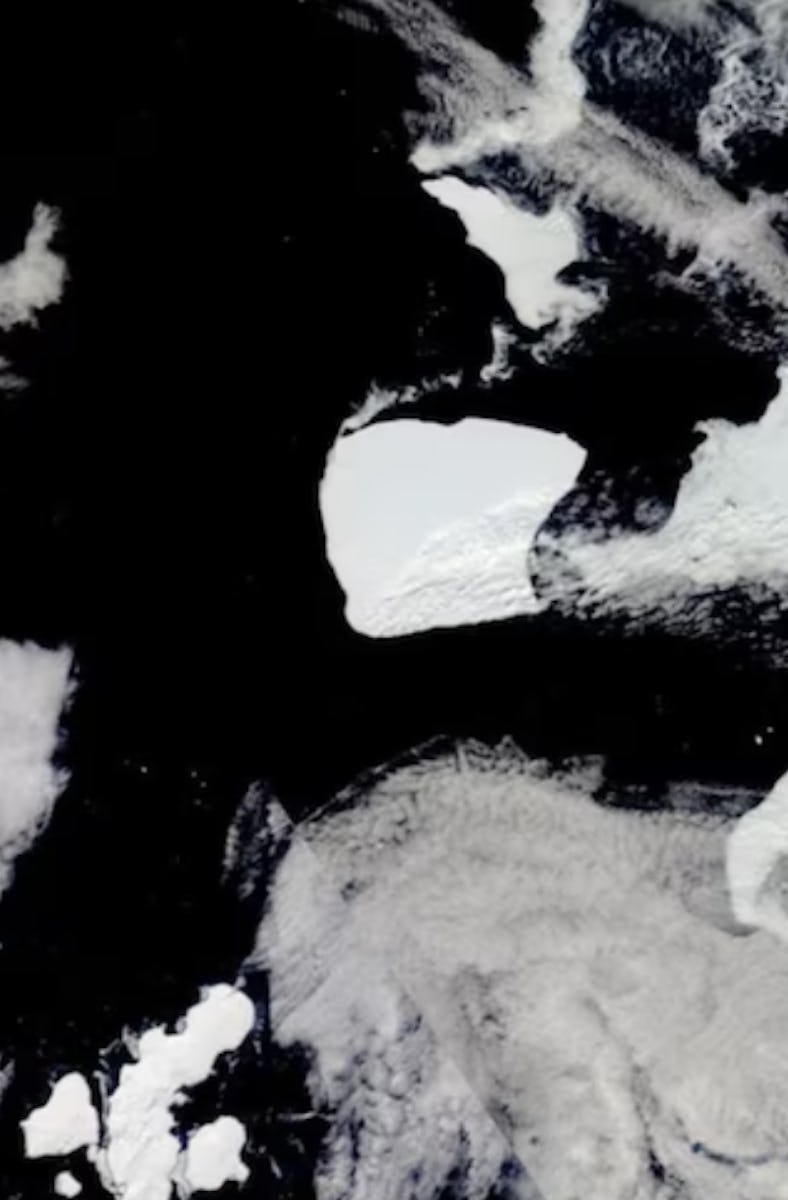Giant Antarctic Iceberg Three Times the Size of New York City Is On The Move
Iceberg A23a is heading to the Southern Ocean. Here's why that could be disastrous.

The largest iceberg ever is making a break for the open waters of the Southern Ocean, and it could be a gigantic problem.
The enormous iceberg, known as A23a, has been drifting since 2020 (haven’t we all). But a European Space Agency satellite caught it rounding the northern tip of the Antarctic Peninsula (a tentacle-like piece of ice-covered land sticking out from West Antarctica to point vaguely toward South America) earlier this week. Depending on where it goes next, A23a could be either a hazard to shipping or an ecological disaster.
Iceberg on the Move
The slab of ice in this picture is 1,300 feet thick and three times the size of New York City.
A23a is about three times the size of New York City, and that’s just the (literal) tip of the iceberg. The giant slab of ice has a surface area of about 1,500 square miles, but it’s also more than 1,300 feet thick, which adds up to more than a trillion tons of frozen water. And now it’s on the move – and scientists can’t predict exactly where it will go next.
The metropolis-sized mountain of ice is on course for the Southern Ocean, the cold, stormy, iceberg-haunted stretch of water that spans the globe between Antarctica and the southern tips of Australia, Africa, and South America. If A23a stays on course – which depends largely on winds and currents – it’s likely to get swept up in the Antarctic Circumpolar Current and into a region of the Southern Ocean known as Iceberg Alley (because it’s where icebergs washing in from Antarctica tend to wind up).
“An iceberg of this scale has the potential to survive for quite a long time in the Southern Ocean, even though it’s much warmer, and it could make its way farther north up toward South Africa, where it can disrupt shipping,” British Antarctic Survey glaciologist Oliver Marsh told Reuters.
On the other hand, there’s a chance A23a could run aground off the coast of South Georgia Island (the remote British territory where Antarctic explorer Ernest Shackleton is buried, and where he and a crew sailed in a lifeboat to seek help after the Endurance sank in 1915). That would be an ecological disaster of epic proportions. If penguins made disaster movies, this one would be a blockbuster.
First, there’s the sheer amount of marine life an ice slab three times the size of New York City would grind to death on the seafloor beneath its tremendous weight. Then there’s the famine that would follow. A gigantic iceberg parked right off the coast would cut off access to the waters in which the island’s population of seals, penguins, and other marine birds forage.
The best-case scenario would be for A23a to break up into smaller chunks of ice before it gets anywhere near South Georgia Island or the shipping lanes.
An Iceberg With a History
A23a isn’t the first giant iceberg to break off the Antarctic ice sheets, and it’s not going to be the last; if anything, we can probably expect to see more of these frozen behemoths in the coming years. But this one is unusual not just because of its staggering size, but because it’s an iceberg with a long history. It’s one of the world’s oldest icebergs, having calved off the edge of West Antarctica’s Filcher-Ronne Ice Shelf in 1986. Shortly thereafter, its bottom got stuck on the floor of the Weddell Sea, leaving the iceberg stranded for the next thirty years.
That changed in 2020 when A23a managed to float again.
“Over time, it’s probably just thinned slightly and got that little bit of extra buoyancy that’s allowed it to lift off the ocean floor and get pushed by ocean currents,” said Marsh. And after meandering around the Weddell Sea for a bit, A23a is finally making a bid for freedom – and potential havoc.
Havoc is something A23a is historically good at; when it first fell into the sea in 1986, it took a whole Soviet research station with it. The Soviet Union set up Druzhnaya II at the edge of the Filcher-Ronne Ice Shelf in 1975 as a seasonal camp, from which scientists worked on mapping the ice shelf and the surrounding area. Around the time the cracks in the ice started appearing, the scientists relocated – but A23a absconded with all their buildings and equipment. Those had to be airlifted off the iceberg to the new camp.